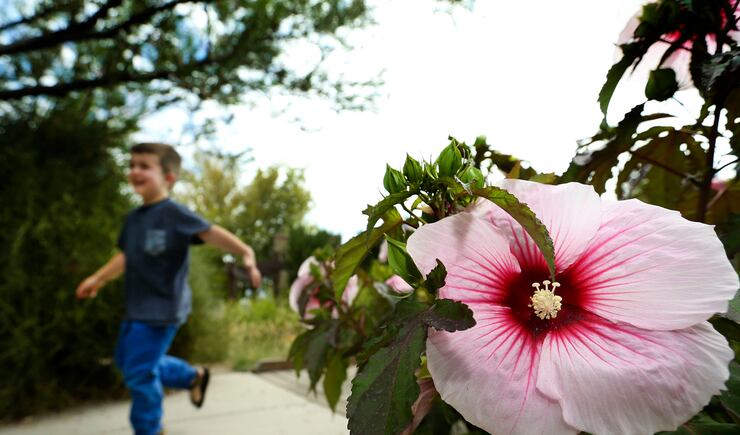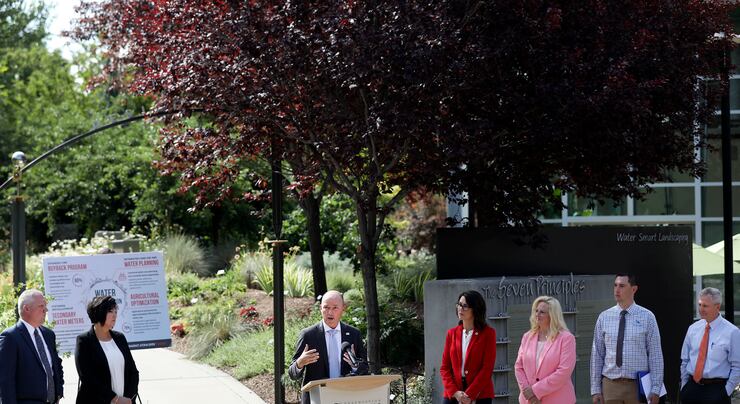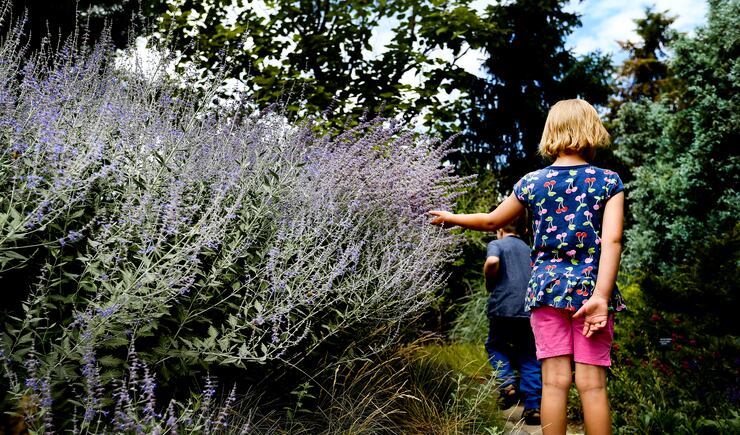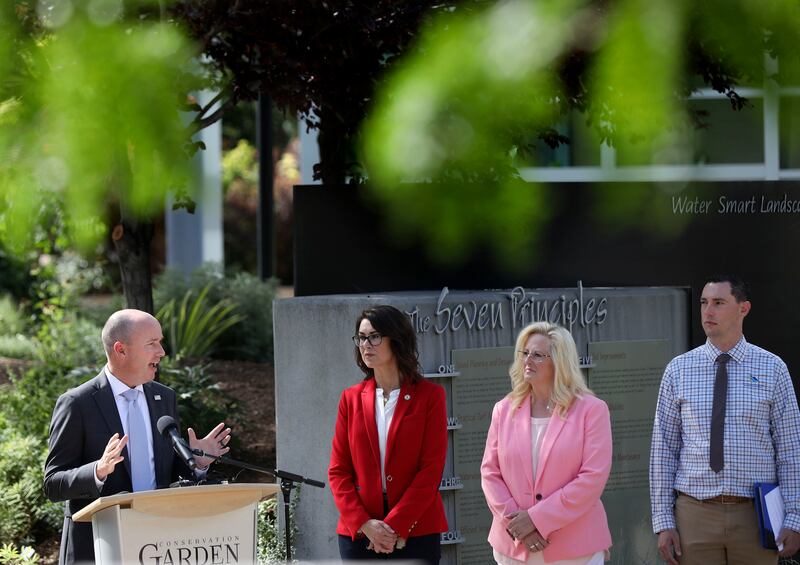Metering all secondary water systems, continuing work with farmers and ranchers to reduce water consumption and starting a statewide turf buyback program are all steps Utah needs to take to be more waterwise, Gov. Spencer Cox said Thursday.

“We have seen significant water reductions in every water district across the state,” Cox said, lauding the efforts of the public and water managers.
Against the backdrop of the Conservation Garden at Jordan Valley Water Conservancy District in West Jordan, Cox called for more action to reduce water consumption.
With upward of 70% of municipal and industrial water used for outdoor landscaping, Cox said it is past time for the state and cities to aggressively embrace water-saving strategies.
While noting that turf buyback programs like Jordan Valley’s Flip Your Strip are local-centric, Cox said he wants Utah to be the first state in the nation to implement its own.
In Jordan Valley’s program, participation in the Flip Your Strip program is up 160% this year. Flip Your Strip involves removing lawn from your park strip and replacing it with water-efficient plants and a drip irrigation system. Doing so will save an estimated 5,000-8,000 gallons of water each year—and homeowners can get cash for doing it.
Central Utah Water Conservancy District announced the launch of two new water conservation incentive programs: its own Flip Your Strip & Localscapes Rewards. Under Flip Your Strip, $1 per square foot is offered or $1.25 per square foot if a free park strip class is attended.
The programs are available to all eight counties within the district’s coverage area and being funded at a half million dollars. It is also being offered at Weber Basin Water Conservancy District because Layton City adopted via an ordinance the institution of the program.
LocalScapes target a revamped landscaping design for residents with “reward money” being distributed based on lot size and water savings. Free Localscapes Rewards programs classes are offered at a variety of locations throughout the state.
The governor also said all secondary water systems should be metered. In cases where metering is already happening, the savings have been as much as 30%. An effort to require all new secondary water connections be metered was brought up legislatively a few years ago, but the bill was modified and not nearly as aggressive as its sponsor wanted it to be.
Cox emphasized, too, that land use planning needs to be integrated with water use planning, but more often than not, that coordination does not take place at the level it should.
With Utah being the second driest state in the nation and in the grip of a protracted drought, Cox said all new development should be accompanied by waterwise landscaping and cites should shelve ordinances that require curbside turf or other mandates.
Across the state there are multiple cities that have enacted various restrictions or taken other measures to cope with the effects of this drought.
Most water providers have moved to a twice-a-week-only irrigation regimen and some are shutting down the season early, such as Davis and Weber Counties Canal Co., which will cease providing water in September.




Saving a finite resource
In information provided at the press conference, officials pointed to water savings in Layton, where residents and businesses have used 94.9 million fewer gallons of water this year compared to last year.
In Sandy, the community has saved more than 234 million gallons of water — the equivalent of 359 Olympic-sized swimming pools.
Last month, Ogden officials declared a moderate water shortage and providers of secondary water from Pineview warned of a potential early shutdown.
As Pineview supplies start to falter, North Ogden passed an ordinance relaxing some rules around use of culinary, or treated water, on shrubs, trees, flowers or for livestock. The city gets its culinary water from a separate series of wells and springs.
City Manager Jon Call said normally the use of any culinary water outside is strictly prohibited, but a shortened irrigation season is requiring flexibility to be built into the system.
Any culinary water use on lawns remains against city ordinance, and residents who abuse that rule could be subject to a fine as high as $250.
Unlike North Ogden, some municipal water providers do not have prohibitions regarding the use of indoor water on outdoor landscaping, but households and businesses just need to be prepared to pay much higher water bills.
Call said this summer has jump-started fruitful discussions by residents on water conservation practices.
“I have been really impressed driving around the city to see how many lawns are following the restrictions.”
For North Ogden resident Chelsea Baker, her family is taking the restrictions in stride.
“I just heard a lot about the drought, grasshoppers in the middle of the country, how it is affecting farmers, and our yard honestly is not amazing. We have not put a lot of time and effort into our yard. We moved here a year ago to the city, so we decided ‘Let’s not worry about it.’”
She puts water on her trees and pumpkins, but that is about it. Despite pleas from her children about running through the sprinklers to ease the summer heat, Baker said her response is a firm “no.”
“The way my yard looks is nowhere as important as it is for farmers to provide food for the state,” Baker said.
She understands that homeowners who have invested a lot of time, money and sweat into having “perfect” landscaping may be dismayed.
“I understand why they may want to use water more, but I think the restrictions we have been given are still enough to keep our yards from completely drying out,” she said. “For us, we just didn’t need it and for those who don’t need the water, it gives a little more for those who need to take a little more.”
While some cities are hitting conservation targets — Lehi reported its residents had dropped their year-over-year water use by 213 acre feet — others are falling short.
Drought challenges
Riverdale in Weber County recently reported its aquifer had dropped 17 feet since May 1 and water conservation goals fell way short of what authorities had hoped. Even though its water is filtered and recycled, the city said it is shutting down its splash pad on Aug. 2 due to some water loss.
Some towns are already out of water, such as Echo in Summit County which has been forced to truck in drinking water from Henefer. In response to the drought, Oakley put a moratorium on any new development and Herriman pressed pause on its landscaping requirements on new development until Sept. 15.
The city said new landscaping, especially lawns, require a lot of water to germinate, and it would be best to wait to plant it in a cooler time of the year.
Salt Lake City Mayor Erin Mendenhall issued a drought advisory in late March, looking ahead to what was predicted to be an unprecedented drought year.
Water-saving strategies are showing some success in unique ways.
The Weber County Sports Complex launched an initiative to do fewer “cuts” at its ice rink and in doing so, anticipates saving more than a million gallons over the year.
Weber County Commissioner Gage Froerer said the move was in response to a countywide conservation plan.
“We have encouraged all of our departments within Weber County to investigate ways to conserve water,” he said, adding the ice rink is one of the county’s larger consumers.
By leaving the ice in this year and not letting it melt and then freeze again, the water savings will be substantial.
“Everybody thinks about grass and gardens, but there are a lot of other uses too,” he said. “This gave us an opportunity to think outside the box, so that is what we did.”
Residents can learn more about rebates and water wise landscaping at UtahWaterSavers.com





